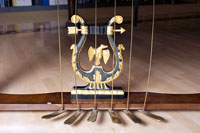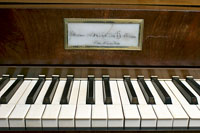Original Fortepiano from ca. 1825 by Mathias Jakesch
This instrument made by the builder Mathias Jakesch is perfectly suited for the performance of Beethoven's middle and late period works. The Jakesch fortepiano came to the Beethoven Center in nearly perfect original condition. It is 7'7" long and 4'2" inches wide, with a keyboard range from C''' to f''''.

There are six pedals, including a single and double moderator, keyboard shift, damper lift, Janissary, and bassoon. Originally this fortepiano was the property of a famous noble family in Siena. The elaborate pedal lyre contains elements from the coat of arms of the Chigi-Gori-Zondadari families.

Eight members of the American Beethoven Society and the College of Humanities and the Arts donated the funds to acquire the instrument from the fortepiano shop of Edward E. Swenson of Trumannsburg, New York.
World-renowned fortepianist Malcolm Bilson, Professor at Cornell University in Ithaca, New York, advised the Center on the acquisition and performed the all-Beethoven inaugural concert in 2001.
About Mathias Jakesch
Mathias Jakesch was born in 1794 in the village of Latein near Brno, Moravia. His much younger brother Franz (1803-1840) was also a fortepiano builder, as was another relative (possibly his uncle), Johann Jakesch (1755-1840). After Mathias's death in Vienna on July 14, 1828 (at the age of 45), his widow continued to operate his shop. Because women were not allowed to raise children entirely on their own, the famous fortepiano builder Conrad Graf, a friend of the family, became guardian of her five children.
Fewer than a handful of fortepianos by Mathias Jakesch are currently known to exist.
For more information, see the Mathias Jakesch's Place and Date of Birth blog article by Michael Lorenz.
